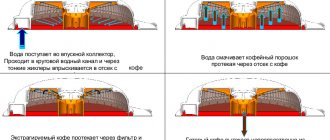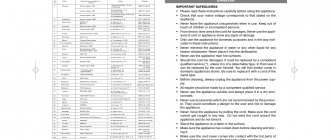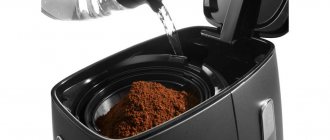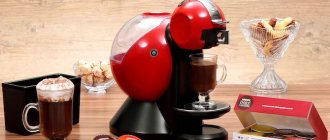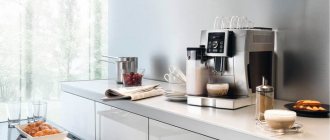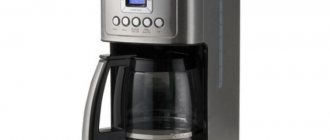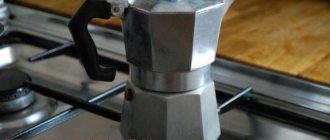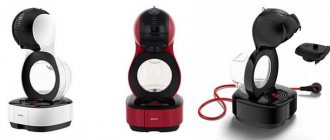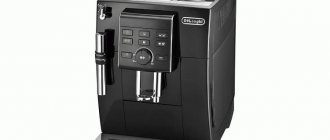The rich aroma of hot coffee wakes you up in the morning, energizing you for the whole working day. In order not to spend a lot of time preparing it, it is easier to use an indispensable “helper” - a coffee maker. The range of such equipment is huge: geyser, drip machine, espresso type machines, etc. But before choosing this equipment for yourself, it would not hurt to understand how a coffee maker works. This knowledge will help not only determine the appropriate model, but also correctly regulate the programs for obtaining a coffee drink.
Drip coffee maker device
This technique is a real find for connoisseurs of strong Americano. Among all automatic coffee makers, drip-type machines have the simplest design and operating principle. What is a drip coffee maker? This is an electric device for preparing freshly brewed coffee, which consists of a heating element, filters and a transparent flask, compactly placed in one housing. A striking example is the Maestro 401-MR coffee maker.
The flask is most often made of heat-resistant glass. Only “budget” models can have plastic analogues. The taste qualities of the future drink directly depend on the material used to make the flask, therefore, its choice should be approached thoroughly. The bowl is equipped with a comfortable handle and measuring scale. In the event of a breakdown or other defect, this part of the coffee maker can be replaced.
What is inside the equipment body? The lower part of the device is occupied by a heating element. This design uses flow-type heating elements, that is, water passing through the part does not come into contact with the walls of the element. The power of the heating elements varies between 650 W and 1200 W. It all depends on the size of the coffee maker and the manufacturer. The second most important indicator is the cooking time. Taking into account the power, the first portion will be ready in about 5 minutes.
At the top of the case there is a water reservoir and a filter compartment. There are 4 types of them that can be used for this technique:
- Nylon - comes with the coffee maker. This filter is enough for 60 brews, after which the accessory will have to be changed.
- Paper - sold separately. These filters are disposable and must be thrown away after each use. The main advantage: low price, as well as the absence of foreign odors and tastes in the drink.
- Iron - suitable for reusable use, but gives coffee a characteristic metallic taste. To avoid this, the part must be thoroughly cleaned.
- “Golden” is an accessory that is more expensive than all the previous ones. Durable, but, like a metal filter, requires regular cleaning.
The water tank can be of different capacities and is often made of durable plastic. When using it, the main thing is to ensure that the volumes of liquid correspond to the indication mark inside the housing.
Caring for your coffee machine
In order for the unit to serve for a long time, you need to take care of it and periodically clean and wash it.
Like all mechanisms, a coffee making machine needs care and cleaning. The specifics of cleaning a coffee machine depend on its type. Some have a special reservoir for used coffee powder. Basically it is designed for ten, maximum fifteen servings. After this, the tank must be cleaned, rinsed and dried, otherwise the tank will become overgrown with mold and begin to emit an unpleasant odor.
The brewing system requires no less maintenance. During the preparation of coffee, oils are released from the powder. Oils add a bitter taste to the finished drink. Despite the fact that not so much is released during each preparation, it is necessary to rinse the brewing system under running water at least once a month. To flush fixed brewing systems, special tablets are used to clean the brewing system. After using them, the device must be washed.
Filtered or bottled water will not save your coffee machine from scale. To prevent clogging of the water unit, it is necessary to descale the system once every two months.
The following care instructions apply to all coffee machines. But just as the way coffee is made is changing, so are the rules for caring for coffee machines. For proper care, please read the instructions for cleaning the device.
If it doesn’t clean for a long time, you’ll have to spend money on repairs.
Many people cannot imagine their morning without a cup of strong, aromatic drink. Coffee making machines have become indispensable assistants for them. Proper care and careful operation will allow the coffee machine to operate for a long time, and its owners will enjoy a wonderful invigorating drink.
Operating principle of drip coffee makers
Rich Americano is prepared in this coffee maker using the percolation method. Water, seeping through a filter with coffee powder, is poured into the flask in separate drops, filling it with a fresh and aromatic drink.
To get a portion of strong coffee, you need:
- fill the tank with water to the indicated level;
- pour the required amount of powder into the filter using a measuring spoon;
- tightly cover the upper part of the case with the lid;
- press the power button.
What happens next inside a drip coffee maker and what is the principle of its operation? After starting the equipment, the water in the tank heats up to 90°C and begins to be pushed upward. Having reached the peak, it drips into the filter with powder, passes through it and, saturated with the taste and smell of coffee, is poured into the bowl. In this case, the drink is obtained without grounds, and all the sediment accumulates on the walls of the filter.
Many coffee makers are equipped with additional functions, for example:
- heated stand - high temperature at the bottom of the device keeps coffee hot for several hours;
- delayed start - this function allows you to select the time after which the equipment will automatically turn on to prepare the drink;
- The anti-drip system is a very convenient technology that prevents coffee from spilling onto the surface if you remove the flask from the stand.
In addition, for some models you can adjust the strength of the drink and its volume.
At the end of the equipment’s operation, it is important to clean the filter (if it is reusable) and rinse the bowl.
French Press type coffee maker
The French press is a glass teapot flask with a handle, which is complemented by a hand press and a metal filter.
The French press is very popular among our compatriots, although more for brewing tea. It is worth noting that the diameter of all flasks is the same, they differ only in height. So, the higher the tank, the more spacious it is. For example, the Bodum BRAZIL 10938-913 French press holds up to a liter of liquid.
Absolutely all bowls are made of impact-resistant and heat-resistant glass. The case can be supplemented with a metal cup holder or individual decorative elements made of steel or plastic. The lid has a hole into which a press is inserted, designed to squeeze out tea leaves or coffee powder. A strainer-filter is installed at the base of this piston, which fits tightly to the walls of the flask during the spin process.
This teapot gained its popularity for:
- reasonable cost, which is much lower than the most “budget” coffee makers;
- ease of maintenance;
- the ability to independently regulate the amount, strength and temperature of coffee.
In addition, the small press is absolutely universal and is also suitable for preparing other drinks: tea, cocktails, squeezing fruit pulp to obtain pure juice, etc.
Operating principle of French Press coffee makers
To prepare a portion of an aromatic coffee drink in a glass press, you will need an electric kettle for boiling water, ground coffee and a spoon for stirring.
The procedure is quite simple and includes 6 steps:
1. First you need to boil water. 2. Whole coffee beans need to be ground in a coffee grinder.
Tip: Under no circumstances should you use a coffee grinder with metal blades - only ceramic ones. Metal spoils the beans, and as a result the coffee is not as aromatic as we would like.
3. The ground powder is poured into a glass container. Approximate proportions: 1 teaspoon per cup of drink.
4. Next, boiling water is poured into the container. Volumes of water are taken depending on the number of servings.
5. In order for the drink to have a rich taste, you need to immediately stir it with a spoon and leave to brew for 3-5 minutes.
6. Now you need to carefully separate the grounds from the clean drink. To do this, you should slowly press your hand on the press so that the filter moves evenly along the walls of the flask.
If you are looking for a coffee grinder, read: How to choose a coffee grinder in 3 steps: a guide for coffee lovers
After this, hot coffee can be poured into cups and enjoy its unique taste.
Correct operation of the coffee machine
Modern coffee machines are quite complex mechanisms; constant monitoring of the technical condition is required to ensure that the machine lasts as long as possible. To avoid breakdowns, you must follow simple rules.
Proper operation of the coffee machine will extend its service life
The first time you turn on the coffee machine is the most important. Everything must be done completely according to the instructions. All subsequent work will depend on correct settings.
For universal coffee machines, the life of the coffee grinder depends on the choice of beans. Flavored coffee beans are not recommended for use in machines that have ceramic or metal blades. Particles of aromatic substances can damage the surface of the knives, and they will begin to become rusty.
In coffee machines for ground coffee, it is not recommended to use coffee that is too finely ground. Fine powder will cause clogging of the brew unit.
A problem for coffee machines can be water that is too hard. When heating or boiling water with a large proportion of iron impurities, scale invariably forms, clogging the system of tubes and hoses through which the liquid is supplied to the powder. In addition to the negative impact on the device itself, the taste and quality of the prepared drink can be affected by scale.
The water unit may fail due to a broken heating element. Prevention of this breakdown is quite simple - you need to monitor the amount of water in the tank and not allow the level to drop below the minimum level.
Geyser coffee maker device
Another device for brewing coffee is a geyser coffee maker. Externally, the device resembles an antique teapot. The device of the coffee maker is quite simple. The case consists of three parts, the material of which can be aluminum, ceramics or stainless steel. The parts are connected to each other using threads, “screwing” onto each other. There is a large handle on the side for easy use.
There is a filter between the two bowls of the coffee maker. Ground coffee is poured into this strainer to obtain an aromatic drink. Another filter, in the form of a tube, is located at the top. Coffee-saturated water is pushed up through it. The upper container is also equipped with a lid and spout for pouring the finished drink.
Coffee makers of this type are electric and conventional, which are placed on the stove when it is turned on. In the latter version, the device replaces the Turk, although the methods of brewing coffee in them are very different.
An important point: the volume of each coffee maker is designed to prepare a certain number of servings of coffee. For example, if the device is made for 6 servings, then cooking just one will be much more difficult, if not impossible.
Variety of coffee drinks
The Bosch capsule coffee machine allows you to prepare your favorite coffee in a matter of minutes. Capsules with ground grains are produced by Kraft Foods. However, only Jacobs Monarch coffee beans are available in our country. As for tea capsules, they are planned to be delivered a little later. Of course, on store shelves there are products designed for use in a model such as Tassimo Professional, which is intended for the office. Using such tea capsules at home is simply impossible.
The coffee assortment is quite large. There is hot chocolate, caramel latte macchiato, simple latte macchiato, cappuccino, Cafe Crema, espresso. One package usually contains 16 capsules, designed for 8 or 16 servings of aromatic drink.
The operating principle of geyser-type coffee makers
To appreciate the “advantages” of making coffee in this device, you need to understand how it works.
The process includes 7 stages:
- The required amount of cold water is poured into the lower container. There must be a mark on the wall of the bowl, which should not be exceeded (as well as pouring less).
- Coffee is poured into a special filter bowl to the brim. There is no need to compact the powder too much, otherwise it will be difficult for water to seep through it. These coffee makers use medium grind coffee.
- Next, you need to install the upper part of the device, checking the tightness of the connection.
- The coffee maker is placed on the stove (gas model) or plugged into an outlet (electric model).
- When the device heats up, the water boils, producing steam.
- It pushes hot water upward, through a filter with coffee and a straw, ending up in a container for the finished drink.
- The action is repeated until all the water from the lower bowl passes into the upper one.
You can tell that the coffee is ready by the characteristic “hissing” sound. The electrical device will turn off automatically when the process is completed.
To please yourself every day with the unsurpassed taste of the drink prepared in the geyser, you should follow a few simple rules. It is better to grind coffee just before the brewing process. Purified water must be used. And you should always check the reliability of the connection between the upper and lower bowl.
Why are there so many bells and whistles inside a coffee machine?
The solenoid is the valve for supplying water to the group. The dispensing group is one of the most important components of a coffee machine. Through it, water heated to 88-92 degrees and 9 atmospheres flows into the holder. The productivity of a coffee machine directly depends on how many dispensing groups there are and how many cups of coffee can be prepared at once.
For uninterrupted operation of the steam that froths the milk, a Panarello steam tap is installed. The boiling water tap supplies heated water for drinks. The water volume sensor speaks and turns off the water flow after dispensing through the dispensing group.
What is a coffee machine?
Some may think that a world without coffee would not lose much. That, after all, perhaps these are the people whose lives have passed by this unusual drink. But since the time the world's population learned to brew coffee, the latter has acquired a huge number of connoisseurs. Now the popularity of the drink is very great. Some people buy cans of coffee, preferring a homely environment, while others prefer comfortable coffee shops. And for both of them, technology that speeds up the process of making this wonderful drink will not be superfluous.
Capsule coffee maker device
Capsule coffee makers are the best choice for those who do not want to waste time washing household appliances. Simply remove the container with used capsules and the device is ready for use again.
It will also be interesting to read: TOP 10 best automatic coffee machines for home: rating from MOYO.UA
How do coffee makers of this type work? To begin with, it would be correct to consider the elements of the device that are located outside the case, because it is these that the buyer focuses on when choosing:
- A tray for cups with a built-in drip tray - this part of the equipment is adjustable in most models, that is, you can independently set the height of the tray depending on the size of the cup. As for the drip tray, it is a strainer at the bottom of the tray and is designed to protect the work surface from contamination by coffee drops.
- Container for spent capsules - located at the bottom of the equipment. Pulls out like a drawer. For mini-models, the capsules must be removed independently.
- Water tank - its volume may vary. Often the part is located at the back of the case and is made of durable plastic.
- Control buttons - their appearance, number and purpose depend on the functionality of the device. Some models have mechanical buttons for setting the portions and strength of the drink, while for others this process is carried out automatically by pressing a specific key.
- Cappuccino maker - can be manual or automatic ("budget" models do not have this function). In the first option, cold milk is poured into a container into which you need to lower the cappuccino maker tube. After turning a special lever, steam is supplied to the cappuccino maker under a certain pressure. Mixing with milk, it turns the liquid into a lush, stable foam. An automatic cappuccino maker performs the same procedure, only for milk there is a separate reservoir on the body of the device. After pressing the button, the steam supply is activated and the finished foamed milk flows into the cup.
Since all the main work of making coffee takes place inside the equipment, it is important to consider what the “filling” of a capsule coffee maker consists of.
Under the device body there is:
- Boiler - here the water is heated to a certain temperature (85-90°C).
- The pump creates a lot of pressure in the equipment, due to which the coffee preparation time is only a couple of minutes.
- Control unit - with its help all working processes of the machine take place. Consists of wires and boards connected to each other. By pressing a button on the case, the user activates the software and launches a particular function.
- Capsule system - ensures correct placement, puncture of capsules and release of waste material into a special container.
- Water dispensers are configured in such a way that a specific key is responsible for the amount of water for a serving of coffee. That is, the user can adjust the volume of liquid for a large and small cup.
Replaceable filters are not used here. They are located in each capsule, framing the coffee on both sides. The capsule itself is a portion of ground coffee hermetically packaged in food-grade plastic, which is designed for one cup.
Structure and components of a coffee machine
Brewing machines have several main parts and are different from coffee makers. There is no fundamental difference between the main elements; there are only design differences depending on the method of preparing the drink. All parts of coffee machines can be linked into functional parts that perform specific actions.
A special container is used to fill and store ground coffee powder or prepared beans. For carob coffee machines, this will be the horn itself (that’s why the machine is called that), and universal machines are equipped with containers into which the beans are poured.
The brewing system is responsible for brewing coffee.
The strength of the drink will depend on the grind of the coffee beans - the finer the grind, the stronger the drink.
Universal coffee machines have a grinding function, so the taste of the drink will depend on their serviceability. Devices operating on capsules, pods or using ground coffee powder are not responsible for the strength of the drink.
Universal machines grind coffee themselves and compact it
The water unit is the system responsible for storing water, heating it and supplying water to the brewing system. The water supplied for making coffee should not be boiling, but heated to a temperature of 80-90 degrees Celsius. Some coffee machines do not use water for brewing, but steam supplied under high pressure.
To maintain hygienic cleanliness, any coffee machine has a tray into which spilled water or the drink itself is drained, and waste is also drained there during automatic cleaning of the machine in universal devices.
Remaining coffee and unused water flow into the drip tray.
To control all processes in coffee machines, there is an electronic microcircuit that connects all components into a single mechanism and controls the process. The machine is controlled using an electronic panel; there is also an indication of the preparation of the drink.
The design of coffee machines varies from type to type and from manufacturer to manufacturer. Additional components and elements in coffee machines are installed depending on the type of device.
In universal machines, a container is installed to collect used coffee, but in carob machines there is no such design - the coffee is poured into the cone, which is shaken out after use.
A capsule machine is equipped with a holder for capsules or pods, and a universal machine is equipped with a filter for accumulating coffee powder after grinding.
Operating principle of capsule coffee makers
To get your dose of an invigorating drink in a capsule coffee maker, the first thing to do is fill the reservoir with water, insert the capsule into a special block and activate the machine.
During these few minutes, the following processes occur inside the device:
- the needle pierces the capsule on both sides;
- the pump pumps water and supplies it to the coffee machine;
- passing by the heating element (boiler), the liquid reaches a temperature of 90°C;
- under high pressure (up to 19 bar), hot water enters the capsule and saturated coffee comes out on the other side;
- filter paper retains the grounds, preventing them from getting into the cup of drink;
- the finished coffee is poured through the tube into the prepared container.
If a device of this type has a cappuccino maker, you can get not only a strong Americano, but also a delicate latte.
And now a few words about the nuances that are worth considering when choosing a capsule coffee maker based on its operating principle:
- Device power. This parameter directly affects the preparation time of a portion of the drink. It is better to buy models with a power of 900 W and higher.
- Tank size. The smaller the capacity of this bowl, the more often you will have to add water to it.
- Pressure. The pressure under which the water enters the capsule affects the strength and taste of the drink. This indicator must be at least 15 bar.
Device of a carob coffee maker
This type of equipment is perhaps one of the most complex devices in the line of equipment for making coffee. It got its name from the holder (horn) into which the powder is poured. What does this miracle machine consist of? First, it’s worth reviewing the external parameters of the device.
On the device body there is:
- The brewing group is the heart of the technology. This is where an aromatic and rich drink from coffee beans is prepared.
- The holder is a removable horn that resembles a strainer with a handle. Powdered coffee is poured into this compact container. Before starting cooking, it must be compacted with a tamper (tamper) and the horn must be put in place.
- Buttons (on and spill) - if everything is clear with the first, then the second is designed to activate the spill of water. In some models, this function is automatic, that is, you can pre-set the required volumes of water per serving, which will be supplied when you press the button.
- A display or light indication is not present in all models, but it greatly facilitates the operation of the equipment. All work processes can be monitored on the display, and an indicator signals their activation.
- Steam Lever - Activates the valve through which steam flows. Most often, hot steam is needed to operate a cappuccino maker (frothing milk) or heating cups, if such a function is provided in the model.
- Cappuccino maker (manual or automatic).
- Boiler and pump pressure gauge - not all models are equipped with them. In addition, devices can be combined in one. Necessary for monitoring pressure in the boiler and brewing group.
- Water reservoir - can be located at the back or side. On some models, this bowl is hidden under the body. It is better if the tank is removable - this makes maintenance much easier.
- Warming panel - located at the top of the coffee maker. This function is available only in more expensive models and is designed to maintain the optimal temperature of the cups.
- Cup tray - has a mesh surface under which a drip tray is installed.
Yes, the body of this equipment has many levers and taps, the purpose of which seems impossible at first glance, and the control process itself is reminiscent of complex gadgets. If the outside of the device looks a little confusing, what's going on inside?
So, hidden under the body of the device:
- Heating boiler (boiler) - there are steel and copper. In this container, water for coffee is heated using a heating element and steam is generated. Expensive models most often have 2 separate boilers installed so that hot steam under pressure does not increase the temperature of the liquid for the coffee drink.
- Pump - pumps water into the boiler and transfers it under pressure to the brewing group. Some models do not have this part and are called “pumpless carob coffee makers.”
What is the difference is indicated in the table:
| Coffee maker type | Pressure, bar | Cooking time | Principle of operation |
| Pump-action | 15 | 0.5 minutes | Water (95°C) under pressure passes through the holder with coffee, becoming saturated with its taste |
| Steam (mopless) | 2-4 | 2 minutes | Boiling water (100°C), turned into steam, passes through the coffee. |
- Steam supply valve - it opens when the corresponding button is pressed.
- Tubes through which hot water and steam pass.
In addition, additional sensors can be installed inside, for example, a water dispenser for a portion of a drink. Its operation is regulated by the user through the control panel.
Operating principle of carob-type coffee makers
To make a cup of coffee, a whole “revolution” is taking place inside the technology. Once the container is filled with water, the compressor begins to pump it into the boiler, where the liquid is heated to a temperature just below the boiling point (95°C). The machine is now ready for use, as indicated by the light indicator on the panel.
The further operating principle of the espresso coffee maker is as follows:
- the holder is filled with coffee (approximately 7 g per 35 ml of drink) and inserted back into the connector;
- on the control panel, select the type of drink, for example, espresso, and press the preparation button;
- a piston is activated inside the body, the speed of which builds up a pressure of about 1500 kPa (this is three times more than the pressure in a bottle of champagne);
- water under such pressure is pumped into the lower boiler, passes through the tubes and enters the holder with ground coffee, and from there into the cup.
A sign of good espresso is a stable foam on its surface. It contains oils and proteins. In addition, the foam is saturated with gas bubbles, which give that incredible coffee aroma. The denser the foam, the longer the drink stays hot.
Automatic coffee maker device
This type of coffee maker prepares a coffee drink with just one click of a button. At the same time, the taste and aroma of coffee will be no worse than that of professional baristas. The secret lies in maximum automation of all processes. But to understand these actions, you need to start with something simple - the design of coffee machines.
Automatic coffee makers consist of a housing on which are placed:
- Control buttons - they are used to activate the required action. The capabilities of such a device include about 10-15 functions, from grinding beans to choosing a drink, its strength, portion, and discarding grounds. A separate button is responsible for each process.
- Cappuccino maker - for this type of machine it is automatic. This means that a special tube sucks milk from the container and foams it using hot steam. The finished foam is poured into a cup. With some equipment you can even adjust the thickness of this foam.
- A bean container is often a transparent container made of durable plastic that holds unground coffee beans.
- Not all coffee machines have a display. The presence of a screen greatly simplifies process control. If the display is touch-sensitive, it also helps to quickly activate the desired mode.
- The waste compartment is a container where waste grounds are collected after brewing a portion of the drink.
- Adjustable group - here the coffee tablet is formed and the drink is prepared using hot water.
Inside the housing there is a pump, a water tank, a boiler, a heat exchanger and tubes through which hot water flows to the dispensing group. All parts have a purpose identical to the carob coffee maker and have already been described above. In addition, the equipment is equipped with additional functions: a coffee grinder, a panel for heating dishes, automatic descaling, etc.
In such a coffee machine you can prepare a drink to suit any taste. A striking example of this is the Saeco Lirika coffee machine. Here you can find a delicate mocchiato, an airy latte with stable foam or a rich espresso. All you need to do is simply press a certain button on the panel.
Basic criteria for choosing a coffee machine
The Italians, the founders of modern coffee traditions, believe that the taste and aroma of the drink depends on the beans themselves (in this article we are not talking about ground or especially instant coffee), on the skills of the barista, as well as on the coffee grinder and, finally, the coffee machine. The last component, given the capabilities of modern equipment, is gaining more and more importance: today many superautomatic machines brew decent espresso with virtually no operator intervention. However, coffee still comes first - if you save on beans, then there is little point in buying expensive equipment.
The choice of a professional coffee machine depends entirely on the characteristics of your business: firstly, it is obvious that in establishments where customers take coffee at the distribution line, a different machine is needed than in a coffee shop or restaurant. Secondly, if the equipment will be serviced by staff, then the professionalism of the barista must be taken into account - to work with some models you will need an experienced specialist, while in others any amateur can handle the operator’s work.
The third factor influencing the choice is the traffic volume of the establishment: what is the average number of cups you plan to sell per hour? Coffee machines differ in their performance: buy one that is too weak, and visitors will have to wait an indecently long time, which will not benefit the reputation of the business at all. On the other hand, an overly powerful device is an unnecessary expense that will take a long time to pay off.
Is it possible to get by with a household coffee machine?
Even with a minimum number of visitors, the option with the most advanced “home” model is unacceptable: such equipment is not intended for streaming work. Many manufacturers of household equipment claim to use professional components in their models, but in business, even seemingly insignificant details such as the quality of internal fasteners or the material from which the case is made can create problems. And small containers for grains, waste and water (the tank must hold at least 2 liters) will entail the need to waste a lot of time servicing the machine. In any case, you still won’t be able to brew really good coffee using a household machine.
In addition, if you intend to offer a real product without any compromises in terms of taste and aroma, then you should not look towards capsule and pod machines: for truly high-quality coffee, fresh grinding is vital. You will either need to buy a professional coffee grinder, or it must be built into the coffee machine. But this is a topic for a separate conversation; here it should only be noted that when using a separate coffee grinder, it should be located as close as possible to the coffee machine so that the barista does not have to run, for example, to the kitchen every time. The appearance of this equipment is also, of course, important: the design must fit into the interior, because coffee is brewed in full view of visitors.
Operating principle of "Automatic" coffee makers
What processes are carried out inside the equipment during the preparation of a portion of freshly brewed coffee? After turning on the equipment, it independently checks the serviceability of all elements: the buttons on the control panel begin to blink in turn with a bright light. If the test is successful, the coffee machine signals with a green light that it is ready for use.
What happens next is:
- water from the reservoir fills the system and heats up to 95°C;
- the user selects the type of coffee drink on the control panel;
- the technique measures the required number of grains for the specified portion;
- the grains go into the coffee grinder, where the knives turn them into powder;
- incredible pressure builds up inside the pump;
- ground coffee is poured into a hopper and pressed;
- a tablet of coffee powder is scalded by boiling water that enters the same bunker under a pressure of 15 bar;
- the finished coffee drink is poured through a tube into a cup or glass;
- the used grounds are immediately and automatically thrown out by the equipment into a waste container.
That's it, the portion of aromatic coffee is ready. After completing the specified chain, the coffee machine stops. Then the user can turn off the equipment or start it up again.
How it works
Unlike competitors, Bosch Tassimo brand coffee machines work somewhat differently. First of all, there are several barcodes on each capsule. One carries service information. When the capsule (T-disk) is installed and all processes for preparing the drink are started, the device begins to read the recipe, which indicates the preparation time, temperature and amount of water. When the coffee is ready, the Bosch coffee machine switches to the “Manual Control” mode. In this case, the user can add more water to the drink or change its strength.
Briefly about the main thing
Knowing the operating principle of a coffee machine, it is easier for the user to decide on the model he needs. For example, capsule machines are relatively inexpensive and their range of drinks is quite extensive. But the capsules themselves are not cheap, and they are different for each car.
If you take carob coffee makers, the richness and taste of the finished drink will directly depend on the design of the device. The presence of a pump makes the coffee tastier and richer, but adds cost to the machine. If this point is important, you should look at a cheap French press or “geyser”.
After reading the article, as well as focusing on personal preferences and budget, purchasing the best coffee maker for your home or office will not be a problem.
Nuances when choosing
Bosch capsule-type home coffee makers with a strength control function are not only attractive in appearance, they are compact in size and capable of preparing a fairly wide range of drinks.
True, coffee can only be brewed from those capsules that are available in the manufacturer’s line , and this slightly limits the choice. However, they are quite sufficient for home use, especially since the taste of coffee brewed using such a machine will always be excellent.
When choosing a specific model from the models offered by Bosch, you should pay attention to the following points:
- the presence of a display makes working with the device easier, but increases its cost;
- the ability to adjust the coffee temperature in some models allows you to prepare a drink at a comfortable temperature (hot, medium or warm);
- In some models, along with the device, the manufacturer includes trial capsules in the kit , which will allow you to choose exactly the drink that suits your taste without purchasing a set of capsules in advance.

